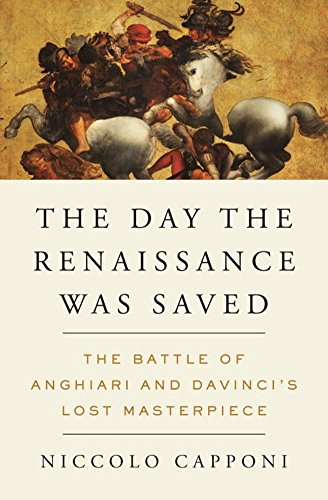
The Day the Renaissance Was Saved
The Battle of Anghiari and da Vinci's Lost Masterpiece
فرمت کتاب
ebook
تاریخ انتشار
2015
نویسنده
Andre Naffis-Sahelyناشر
Melville Houseشابک
9781612194615
کتاب های مرتبط
- اطلاعات
- نقد و بررسی
- دیدگاه کاربران
نقد و بررسی

November 23, 2015
Italian Renaissance scholar Capponi (An Unlikely Prince) juxtaposes the high-stakes events surrounding the critical 15th-century Battle of Anghiari, fought between Florence and Milan, with gentle depictions of the famous painter who was later paid to immortalize the battle. Creatively linking politics, art, and the way victors in the former shaped the creators of the latter, Capponi provides an intense but relatable look at key Italian families in the era's unforgiving struggles between the influence of city-states and papal power. Amid the generations of allies and antagonists, Capponi includes a generous look at his own family, citing one ancestor (Machiavelli) regarding the loyalty of another (Neri Capponi) as well as sharing insight into his own extensive family lore. There are so many figures central to the story, including the immediately recognizable and rising Cosimo de' Medici, that readers would benefit from a list of names and affiliations. The narrative itself flows smoothly in Naffis-Sahely's English translation, allowing Capponi's smart imagery to shine through as he illuminates Florence's successful struggle for survival.

October 1, 2015
Capponi (An Unlikely Prince: The Life and Times of Machiavelli, 2010, etc.), a descendant of one of Florence's most prominent families, has the inside track on the beginnings of the Medici rule and their patronage of the great rebirth of art and architecture. The author explains the politics of Italy, with its papal states, succession of popes, city-state squabbles, and different mercenaries. A good background in Italy's history and geography is necessary for comprehension, but there is considerable difficulty keeping track of rulers, their sons, and those who usurp them]as well as deciphering their allegiances. Military leaders are just as confusing, as they frequently changed their ties with the wind (and purse), and Capponi alternates referring to characters by their first names, last names, or titles. In the early 15th century, there was considerable conflict among Milan, Venice, and Florence. Each city in Northern Italy was affected, either by promises of support, marriages, or threats of side wars with or against Genoa, Lucca, Pisa, and any other city along the supply routes. The author thoroughly enlightens readers regarding the inner workings of the armies and of Florence's politics. The defeat of the papal army and the Duke of Milan at the Battle of Anghiari gave the area time to rebuild. Then came the rise of the Medici, who financed the transformation of art and helped begin the Renaissance. The book lacks as art history]there are only a few mentions of artists and short chapter-heading pieces about da Vinci's lost painting of the Battle of Anghiari]but as military history, it shines. There is so much information]much of it useful but some superfluous]that this could easily be used as a textbook. Tracking the characters, their treachery, and the many battles will tax many general readers.
COPYRIGHT(2015) Kirkus Reviews, ALL RIGHTS RESERVED.

November 15, 2015
Historian, professor, and direct descendent of Niccolo Machiavelli, Capponi (An Unlikely Prince; Victory of the West) presents a scholarly yet engaging account of the events leading up to and including the little-known, historically significant Battle of Anghiari. He also tells the related story of the lost and recently rediscovered fresco commemorating the battle that Leonardo da Vinci painted on the wall of Florence's Palazzo della Signoria. The author claims that the Italian Renaissance was "saved" on June 29, 1440, near the Tuscan town of Anghiari, when the armies of Florence, Venice, and the Papal States defeated the previously unstoppable army of the Republic of Milan, bringing the Medici family to power in Florence. Weaving the story of Leonardo's masterpiece into his narrative, Capponi sets forth the military and political factors leading to the renaissance. While he discusses some art history and culture, he doesn't provide a very detailed or thoroughly researched art historical account of the time. VERDICT A significant survey of an important battle and its outcomes as retold by an expert of Italian Renaissance military and political history, this book will be of interest mostly to scholars, graduate students, and some general readers of the subject. For both large public and academic libraries.--Cheryl Ann Lajos, Free Lib. of Philadelphia
Copyright 2015 Library Journal, LLC Used with permission.

























دیدگاه کاربران